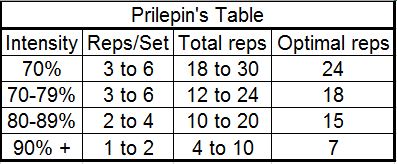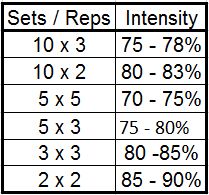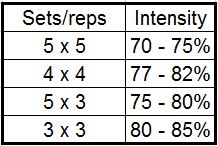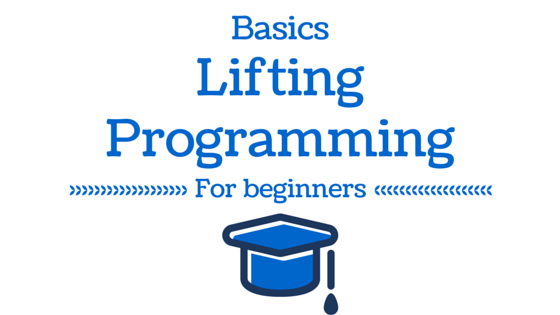Basics of lifting programming for beginners
This article is geared towards providing you with a general overview of the basic tools to understand how to evaluate weightlifting programs for your personal needs. I will not cover Olympic lifts in this article, as I personally think they are not that suitable for beginners and I personally also have no experience with them so far.
Experimentation is key
In all you will do for yourself and together with your trainers your overwriting principle should be to always be willing to learn more and experiment with different schools of weightlifting to find the optimum recipe for your personal goals and body. If you look deeper into the respective programs ang blogs you will find several athletes on different programs who produced respectable results.Your personal attitude will matter most in how far you can take a program and your body.
If you lift bad and do not progress first and furthermost the most likely culprit will be yourself. Not the equipment at hand, not your trainer and not your program. Keep this in mind when reading on.
However, by laws of physics and biomechanics, certain ways of training are more likely to produce one desirable result over the other based on their structure. Your own experience and experience of others with these programs will help. So learn, share and try to improve. The fact that you are investing the time to read this article already shows that you are serious.
Variables in training
The most commonly known and referred to variables in weight training are numbers of repetition and amount of weight. These are the easiest to understand and most obvious, as even a seven year old understands that it harder to lift a bigger weight more often than a smaller weight. Once I dug deeper into training, and especially crossfit, I soon realized that there more variables than these two. This realisation helped to find more points to push myself out of my comfort zone to make gains.
The variables are:
- Number of repetitions
- Weight lifted
- Load modifications
- Time to recovery
- Output over time
- Overall tonnage
- Time under tension
- Number of training sessions per week
- Overall time of a program
- Stance
- Speed of Execution
- Range of motion
Number of repetitions
The number of repetitions os determined by how often a movement is being performed without any rest. Someone who can more repetitions with the same amount of weight ist stringer than the other one who can do less
Weight lifted
This relates to the weight which you actually lift, either put on a barbell or dumbbell, take your pick. In europe you will most likely talk about kilograms, while in the United States and UK you will most likely talk about pounds. This sometimes can be annoying when searching for programs and reading literature if they use the metric which is not local to you.
Load modifications
This is a principle I first discovered doing research into the westside method and is not that commonly known in commercial gyms and people who just start out training. If you use a band for resistance or put chains on your barbell, your the load of your pull up or bench press performed will modify during the movement rather than stay the same.
The band will help you most in providing upwards force in the deepest point of the pull steadily decreasing the further you go up. The chains on the bench press will deliver the highest load to you in the highest point of the press at full lockout and the least in the lowest point of the lift.
This concept can be used to break through plateaus for overall weight lifted. If you bench 100kg without load modification and you can not get pass it, maybe try to load 80kg on the barbell and add 25kg of chains for a total of 105kg. By this the load in the lowest point of the bench press will most likely around 85 - 95 kg and steadily progress towards the 105kg.
When you go back to the 100kg lift you might by able to complete your full sets to move on.
Time to recovery
An individual who can lift 5x5 100kg two times with only one minute rest between sets is stringer than someone who rests for five minutes between sets. This concept really hot home with me when I was doing research an breakingmuscle. You can modify your rest intervals, to make the individual workout session more or less challenging. This is also the main reason, why I am personally minimising talk time in the gym, rather than maximising it.
Output over time
Another concept I started to understand better through crossfit. A woman who can do 100 push ups in one minute is tsringer than a woman who can do 100 push ups in two minutes, even if both of these sets are unbroken.
Time under tension
Closely related to output over time, but still slightly different. This basically says, that there are ideal windows on how long your should keep your muscles under tension (translates to how long your set takes) to achieve a certain goal. This table gives you an overview in relation to your goals & repetitions

Overall tonnage
Tonnage is the total amount of weight you have lifted over a certain period of time multiplying your repetitions with the weigh lifted for a given session. Your aim to get stringer should be that overall tonnage steadily increases, if your aim is strength gains. Tonnage is one of the simplest methos to compare different programs.
Number of training sessions per week
The more someone can train a week under high load, the fitter he is. There is a lot of talk on the net about overtraining and periodisations, which all have their place. In my personal opninion this is only relevant for poeple who want to compete and have to build a peak into their performances which has an overlay with the day of their respective competition.
For mere mortals I think, do not make excuses because of programming and get out there and train. Ramp up slowly to avoid injury because of overuse, but otherwise get out there and train.
Overall time of a program
Take into consideration how long a program is. Some programs have baked in periods which can not really be divided or stopped at any given point without making massive sacrifices. So be smart and think first of you want to commit to Smolov which is a 13 week program or stick to a 4 week German Volume Training template.
Grip
For each lift you can vary the grip which makes the lift easier harder or easier depending on your overall physique. Some positioning will give you more leverage than others. Make use of this concept to vary your training as needed.
Stance
Same principle as with the stance. You can decide if you lean against a wall, lay on the ground, do an incline or decline push up / bench press and how wide your feet are apart on the back squat.
Speed of execution
The higher the speed of the bar, the more velocity the lifter produces, therefore the stringer he is or more capable to transpose his strength into actual force on the weight due to better technique (the strongest engine with an inadequate gearbox will never get its full horse powers on the street to produce forward force).
Range of motion
The longer the movement and fuller the range of motion with the same amount of weight between two lifts the stronger the lift is. Powerlifters use this concept to their advanatge by minimizing the way the bar has to travel in the benchpress by arching their backs, which is within the rules of most Powerlifting associations.
Prilepin's table

Intensity in this table defines the percentage of your one repetition maximum weight for the lift you perform. If you your maximum for one rep on the squat is 100kg 70% means 70kg. A.S. Prilepin used data from the 60s and 70s of his athletes to come up with a generally applicable system of optimum repetitions at a certain load to train.
Generalisations are usually problematic due to specifics of each athlete and might not hold true for you. However it is good to know this table to make an informed call of where the programs describes in this article stand in relation to this. If you go out the boundaries of the table you can conveniently assume that the program is aimed at shocking your system / overloading you to get gains. If it is remarkably below this, you can conveniently assume, that it is a less challenging program and more suitable for general conditioning rather than strength gains.
Loading guidelines for the back squat and deadlift

The back squat will most likely be a centerpiece or one of the central lifts you will be doing either for crossfit, olympic weightlifting or powerlifting. This table is to help you to decide on load and how to switch you training up for the back squat. Again just as a general guideline that may vary between individuals. The more experienced you get, the most likely you will deviate from these basics to achieve the results you are aiming for based in your training history and build.
Loading guidelines for the push press and bench press

For the Overhead press or push press you will do considerably lower weight than for the back squat. The bench press might be close, but should generally be lower than your back squat.
Further reading
On the deadlift
- 7 simple ways to gain on the deadlift
- 72 deadlift dynamite quotes which will make you pull more
- Best deadlift dynamite review which will make you pull more
- Can kettlebell swings replace deadlifts?
- Can you use
smolov for the deadlift? - Try this deadlift thing to get strong like bull
- Selected quotes from deadlift dynamite that will make you stronger
- Which is harder bench press
oder deadlift? - Why are there only 1x5 deadlifts in Stronglifts 5x5
On the squat
- Are you sure about wearing the right shoes for squatting
- Bench press or squat first
- Bench press in a squat rack
- Better breathing makes your squat stronger
- Breathing Squat
- Can kettlebells swings replace squats
- Can you squat and deadlift on the same day
- Challenge, Sore
toda , Strong tomorrow - Confidential: Get rid of the machines and hire the squat
- Detailed Smolov squat routine review
- Eager to know about wearing the right suit for squatting
- How to perform a back squat for
crossfit for beginners - How years of quality cossack squats easily help your fitness
- Overcome these sins of the squat
- Squat: How many reps
- Squat: How to improve
- Squat: When to inhale and exhale
- Squat without pads
- Squat Calculator [Free Downloads]
- The Truth squat or lunges?
- Ultimate 30 day squat challenge that
tighten and tone - What squat is best
- Why are there so many squats in Stronglifts 5x5
On the bench press
- 6 common mistakes when you bench press for strength
- An easy guide to bench press like a powerlifter for any age
- Bench press or floor press
- Bench Press or Military Press
- Eliminate these mistakes with the bench press
- How accurate are bench press calculators
- How to bench press 300 pounds or 140kg
- How to bench press for Stronglifts
- How to bench press more weight quick
- How to do the bench press properly
- How to increase your bench press
- The reasons why you need to bench press
- What are bench press boards
- What does the bench press target
- When you should bench press with dumbbells
- Which bench press is best for chest
- Who can bench press 1000 pounds
- Why bench press with bands
- Why bench press with chains
- Why is the bench press so popular
- Why use a bench press shirt


